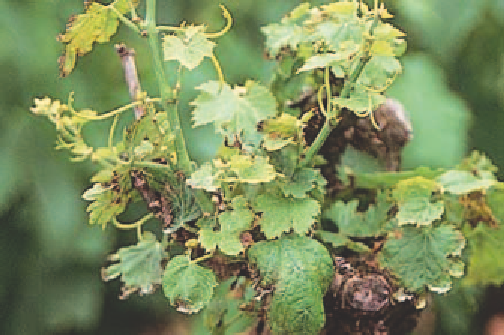Agriculture Reference
In-Depth Information
are carried in air currents to recent pruning cuts. Infection
is more common on large pruning wounds (greater than
three centimetres in diameter); for example, made during
top-working. The fungus grows into and blocks the water-
conducting vessels (xylem), eventually killing the arm or
the entire top-worked vine. Symptoms on foliage are seen
four to six years after infection.
Importance
Eutypa is rarely a commercial problem in vineyards except
in high rainfall zones, where pruning and top-working are
carried out during wet weather.
Fig 9.20 Tattered and curled leaves on a shoot stunted by Eutypa.
Management
•
Search for and remove and burn diseased arms in early
spring when they are easiest to detect in the vineyard.
one or more arms of a vine arm. Rarely is the whole vine
affected. Badly affected leaves develop small brown spots
and shoots are usually stunted but are soon enclosed by
adjacent healthy foliage.
Neighbouring shoots toward the trunk and later, whole
arms may slowly decline and die. A cross-section of wood
cut from a diseased arm shows a dark brown wedge-shaped
zone of dead sapwood.
Remove stumps of diseased vines and where possible,
dead branches on other hosts, as these may provide a
source of infection.
•
To minimise the risk of infection, where possible, prune
vines in dry weather (summer) when the rate of healing
wounds is highest, or in early winter (June) when spore
production is low.
•
Treat large pruning or top-working cuts in wood two
years old or older by painting them with a water-based
(acrylic) paint or other wound protectants immediately
after pruning to provide a physical barrier to infection
and protect the vine. Trichoseal, a formulation of strains
of the fungus
Trichoderma
, is the only product registered
for the control of Eutypa .
•
Source of infection and spread
The fungus has a wide host range among fruit and
ornamental trees, including apricot, almond, plum, apple,
black current and pear. The fungus survives as small black
fruiting bodies (perithecia) on infected woody tissue. The
fruiting bodies release spores (ascospores) after rain, which
GRAPEVINE LEAF RUST - BIOSECURITY THREAT
Cause
The fungus
Phakopsora euvitis
.
Symptoms
Small, dark, angular spots appear on the upper surface of
leaves while pustules containing large numbers of rusty-
yellow, powdery spores develop on the undersides of these
spots. The pustules may also be present on petioles, young
shoots and bunch stalks (peduncles and pedicels). The
pustules are more common on mature leaves and severely
affected leaves turn yellow and may fall early.
Source of infection and spread
The fungus lives on few plants outside the family Vitaceae
and in most areas where it occurs, the fungus survives as
Fig 9.21 Symptoms of grape rust on a leaf.













